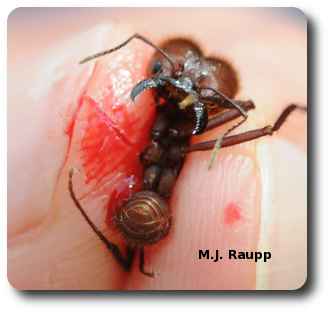During winter break, some adventurous students at the University of Maryland participated in a course that took them on a remarkable adventure to the rainforest in Belize to study Mayan culture and learn about fascinating creatures and plants in tropical ecosystems. By some strange coincidence and a stroke of good fortune, Bug of the Week happened to escape the chilly grip of winter and stow away on this tropical odyssey. This week we visit the most important group of herbivores found in tropical forests in the New World, leafcutter ants. In Belize leafcutter ants are known as Wiwis. In addition to humans, leafcutter ants are one of only a few species known to cultivate a crop for food.
Jaws of leafcutter ant soldiers can open wounds.
Night and day members of the worker caste search for nutritious leaves on trees, vines, and shrubs. When scouts find a good food source, they direct other workers to the bounty by releasing trail-marking chemicals called pheromones. With powerful jaws, workers clip small sections of leaves and carry them to the ground where they join a rambunctious procession of nest mates. In this parade, intermediate sized workers busily transport leaf sections while smaller workers sometimes hitchhike on leaves and help defend their sisters from marauding predators and parasitic flies. Nearby, large imposing workers called soldiers also defend their sisters and the colony with powerful jaws.
Ventilation shafts cool the underground ant colony and provide for the exchange of gasses.
As leafcutters remove foliage from a tree, a parade of ants may extend for distances of more than 200 yards as workers carry leafy cargo back to a subterranean nest. A leafcutter nest is a marvelous structure that may contain several million ants and occupy 600 square meters of forest floor. Sophisticated ventilation systems cool the bustling nest and allow carbon dioxide to escape while drawing in oxygen. Once inside the nest, leaves are delivered to other workers that take leaf sections and clip them into ever smaller fragments. These fragments are carefully inserted into a garden of living fungus maintained by the ants. Leaves serve as a substrate for fungal growth that is harvested as the source of food for the ant colony. The fungus garden is meticulously tended by workers. Destructive alien fungi are detected and removed. Secretions produced by the queen and workers facilitate the growth of the cultivated fungus. Fungal strands produce specialized structures called gongylidia. Gongylidia are harvested and fed to the developing larvae and distributed throughout the colony to feed workers and the queen. Due to their agrarian life style, leafcutter ants are also commonly called fungus growing ants. To support their enormous colonies, leafcutters remove vast amounts of vegetation each day. It is estimated that large colonies may remove more than 500 dry weight pounds of vegetation annually. When nests are established near orchards or crops, leafcutters can strip trees and vegetables overnight. Often, irate farmers destroy their colonies. In the jungles of Belize, legions of leafcutters are the consummate farmers in the rainforest.
References:
We thank the hearty crew of BSCI 279M: Tropical Biology in Belize for providing the inspiration for this Bug of the Week. The wonderful book "The Ants" by Bert Hölldobler and Edward O. Wilson was used as a reference. For more information on leafcutter ants, please visit the following web sites.
http://animaldiversity.ummz.umich.edu/site/accounts/information/Atta_sexdens.html
http://www.bristolzoo.org.uk/learning/animals/invertebrates/ant


